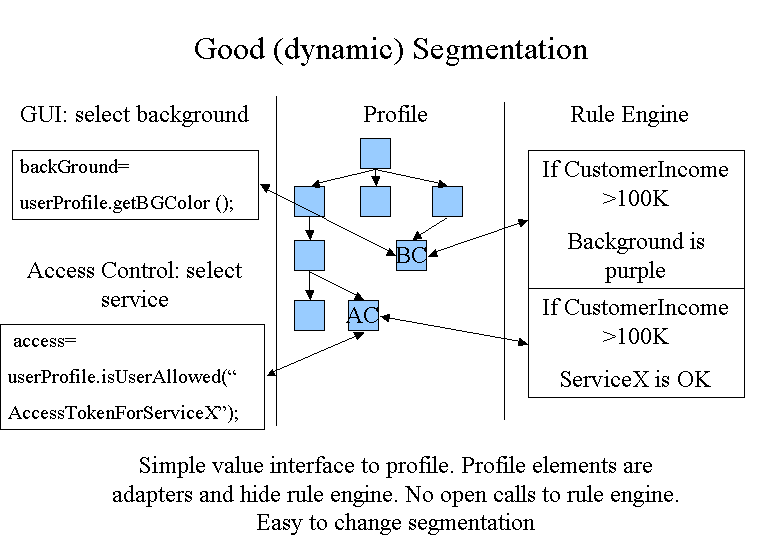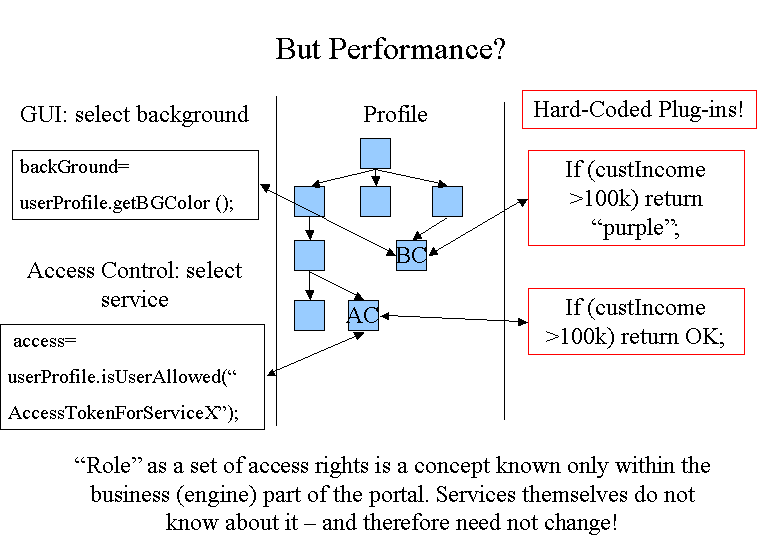A better way to do customer segmentation is shown in the picture below:
here the GUI asks a profile interface directly for the background color. It does not hard-code any knowledge about segmentation - in fact, it has no concept of customer segmentation at all. The profile interface (see below) offers a hierarchical name-value interface to clients, thereby hiding concrete implementations of the values behind its interface. Here we are using it to hide a rule engine behind the profile interface. It is obvious how the GUI code has become independent of customer type changes, but why would we want to hide the rule engine behind a profile interface? What's wrong with just calling the rule engine e.g. engine.calculateBackgroundColor(user); ? This is what we call a service interface: The rule engine works like a service and whoever needs something calls one of its service methods. The downside of such a design - as work in the CORBA services has shown -is that it is hard to change because of those service calls that get spread all over the place. And on top of it: what if we need to replace the rule engine (at least for some results) because of performance reasons? Hiding the engine behind a profile interface allows us to selectively calculate results e.g. through hard-coded plug-ins instead of going to the rule engine.The profile construct should not be confused with what many portal packages call the customer profile as a set of attributes in a customer table. Instead, it combines all kinds of customer related information and hides it behind a hierarchical name-value based tree, not unlike a DOM tree. Its biggest advantages are: It hides different data sources (e.g. some customer information coming from a Lightweight Directory Service (LDAP) base, others from the local portal database). But on top of that it allows customer information to be calculated dynamically either through a rule engine or plug-ins. The users of the profile interface will not see the difference. The result is that certain business concepts (like customer segmentation) can be restricted to the business rule level, expressed in rules for the rule engine. Changes to the business logic are changes to rules and not to portal code.
Roughly modeled after the J2EE security model, our portal differs in one important aspect: A user or principal may have several roles but these roles are only sets of so called access tokens. During access control (e.g. when a request needs to be validated in the controller servlet) only the access tokens are compared against what the service itself requires. A customers roles form the combined set of access tokens for this customer. No service understands the roles themselves. The roles belong to the business conceptual level.
This gives a lot of flexibility but requires an implementation that is both fast and maintainable. For the first release of the portal it was decided to map the access tokens to tables in the portal database. The combination of a users types into the set of access tokens was done through stored procedures that created a dynamic view of the final access tokens per customer. A propagation logic propagated new access tokens automatically to the view.
The AccessControler Interface allowed us to dynamically change the stored access tokens by asking the rule engine, much like we do in the GUI case by asking the profile interface. The AccessController Interface followed the design principle of "design for change and exception" by allowing non-hierarchical and overlapping sets of access tokens. The price to pay was an extra table mapping roles (types) to access tokens and a "non-defaults" table for those cases where individual users received special access tokens without really changing roles or getting roles added.
A very important concept that we tried to implement was "service management delegation". The ability for internal users to maintain the access rights for their parts of the portal. See: Maintainability

